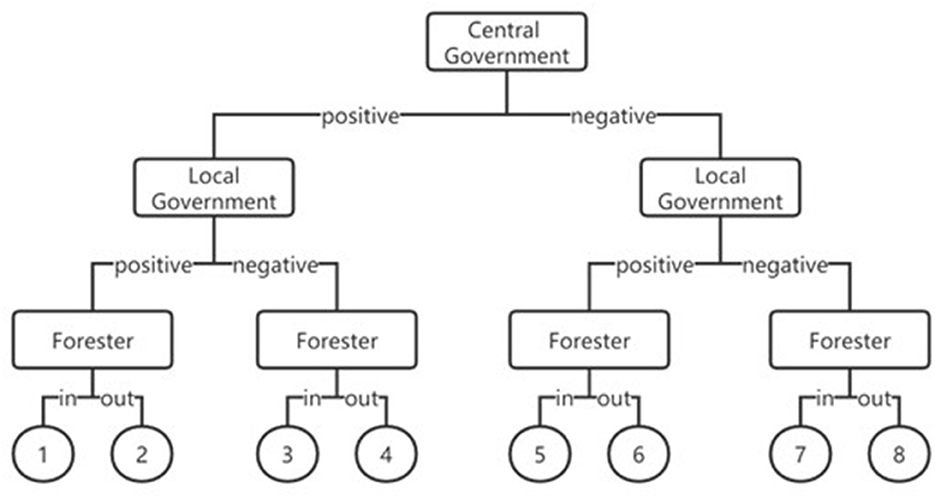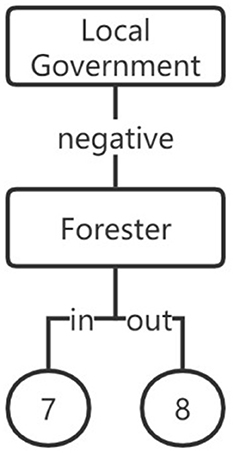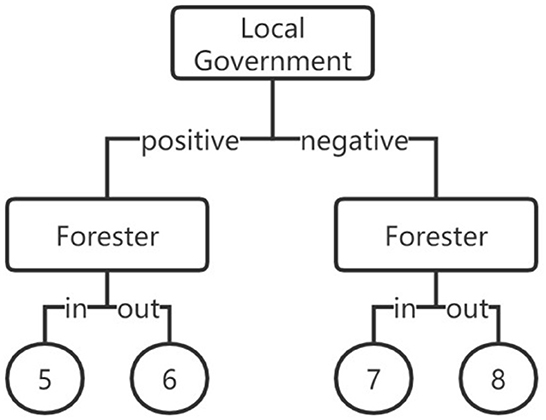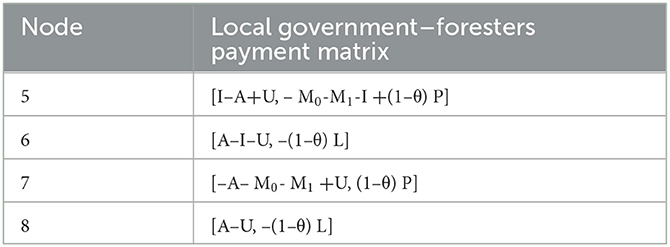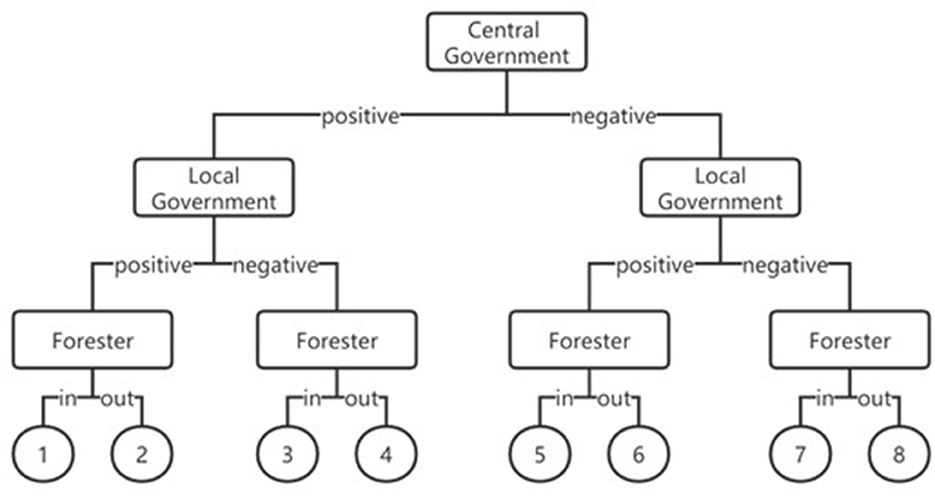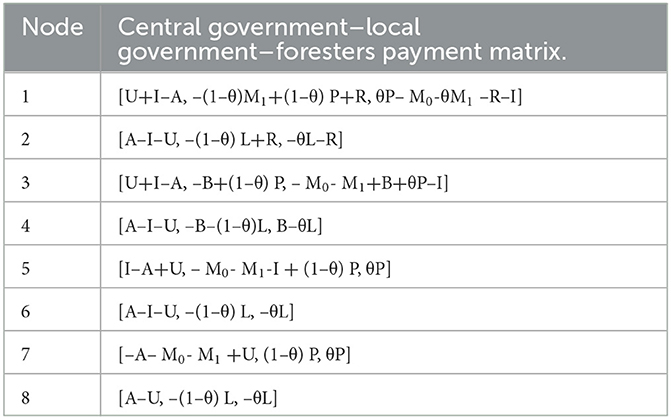- 1School of Economics & Management, Beijing Forestry University, Beijing, China
- 2National Academy of Forestry and Grassland Administration, Beijing, China
- 3Urbanization Research Institute, Beijing City University, Beijing, China
To understand the behavior of the main participants in public welfare forest projects, this article constructs a “forest farmers–local government–central government” dynamic game model by setting the game scope and game principles. The game payment matrix and game equilibrium solutions show that (1) expanding the value of ecological products in the forest to improve operating income will increase the participation of forest farmers; (2) the local government's enthusiasm for leading public welfare forest projects is mainly influenced by the positive effects of planting and management costs, which provides the theoretical basis for central government to intervene in regional ecological governance; (3) when the central government leads public welfare forest projects, the enthusiasm of the local government for afforestation is positively influenced by the central government's subsidies. Finally, based on the game equilibrium solution, the expected results of forest farmers' operational income are calculated using the case of Jiangxi, which confirms the importance of increasing forest farmers' operational income.
1. Introduction
Since the turn of the 21st century, the contradiction between the environment and the development of China has become increasingly prominent. Ecological problems, such as haze and sandstorms, are frequent. On this basis, the government has decided to develop a forestry plan. In recent years, the number of public welfare forestry projects has been increasing rapidly, and the amount of investment has also gradually increased, especially in construction to maintain the original ecological environment. The government has promoted several key forestry projects in succession, for example, natural forest protection projects, forestation engineering, and the “Jing-Jin-Ji” sandstorm control project. In public welfare forestry projects, the distribution of interests and responsibilities among the major players has become increasingly obvious and important. This article focuses on the application of fund allocation, economic benefits, responsibility, and reciprocity in a game, which involves the main participants of a public welfare forestry project.
Forestry projects have both material and ecological implications for public welfare. A public welfare forestry project needs the participation of farmers, village collectives, the government, and various social organizations. After the forestry project forms at a certain scale, it shows the externality of forestry. Therefore, it is necessary to identify and deepen the analysis of many key players in public welfare forestry projects to clarify the role and influence of the main participants in reform to facilitate the implementation of public welfare forestry projects and to ensure the distribution of ultimate ecological, economic, and social benefits.
1.1. Public welfare forestry project
The government's investment project is a fixed asset investment project constructed through financial investment, issuance of treasury bonds or local fiscal bonds, foreign government grants, financial guarantees of domestic and foreign financial organizations, loans, and administrative income (Shen et al., 2014). Governmental investment project funds mainly come from public funds, which ultimately come from all taxpayers. This defines the public nature of government investment projects, meaning these projects impact broad masses of people (Zhang and Feng, 2014).
A public welfare forestry project is a project in which investment by the government is the main activity. Forestry has a complex ecological, economic, and social function. It cannot be a substitute for the construction of diverse ecological environments and is a powerful guarantee of the development of an ecological civilization. A public welfare forestry project defines forestry's economic externalities, which include carbon sinks, sand fixation, and water conservation (Milton and Gregory, 2008). Therefore, in the obvious contradiction between the ecological environment and economic development, the problem faced in Chinese contemporary forestry is how to promote a favorable relationship between the two. It also means that the government's dominant position in China's forestry construction cannot be shaken in the short term. The special nature of public welfare forestry projects is that the short-term/long-term benefits of forestry projects show strong ecological and social benefits but have few economic benefits. Thus, public welfare forestry projects should emphasize economic externalities when defining the main players' motivation.
1.2. Major players in public welfare forestry projects
Project participants belong to a biological system, and their purpose and various activities are to achieve the functions such as carbon sequestration, water conservation, biodiversity, etc. (Wu et al., 2021). In organizations, people's behavior is influenced by factors related to measurement standards and remuneration in their thought (Wang, 2011). The most important stakeholders in a construction project are the project owners, construction supervision companies, and construction contractors; thus, project participants mainly refer to the owners, contractors, and supervisors participating in the construction project and who should be regarded as equal in terms of their interests and positions (Peng et al., 2007).
Based on the above definition of the major players, the major players' definition of a public welfare forestry project in this article is as follows: it defines people who have “Put a certain ‘specific investment' into the individual or organization of the public welfare forestry project, and therefore, they need to take some form of risk in this course of the project, for they can influence the expectations and implementation of the project”.
This definition reflects the fact that the major players in a public welfare forestry project must carry out “specific investments” for this reform (Liu and Li, 2016). The government's “specialized investment” includes financial investment, human capital investment, and monopoly resources (Xu, 2016), while the forest farmers' “specialized investment” includes skill investment and labor investment (Wu and Zhang, 2015). In addition, the main participants in a public forestry project should bear the risks faced in the public welfare forestry projects (Ji, 2015). Finally, the main participants in a public forestry project must be affected by the objectives of the implementation project, which may have either negative or positive effect (Fei, 2015). According to research, the main determinant participants in the reform of the collective forest tenure system include the central government, local government, and forest farmers, which have high legitimacy, high influence, and high urgency and have the closest relationship with the project (Wu, 2014).
1.3. Analysis of rights of the major players
The article defines foresters as “social beings” because they seek to maximize their interests and also measure the social impact of their behavior, which is the basis of all behavioral strategies (Lin, 2013; Qian, 2015; Wang, 2015).
As a member of society, foresters do not have long-term income from afforestation or public welfare forest projects. Their compensation includes government funding, subsidies, salary income, and income from the undergrowth economy. Therefore, whether foresters participate in afforestation projects depends on the government's labor compensation for them and also on the individual forester's sense of social responsibility (Zhang, 2012; Han and Fei, 2013; Zhou, 2014). According to externality theory, the standard of forestry subsidies should reach an ecological value that it can achieve; that is, the subsidy of forestry production should reach the marginal external benefit level of the optimal production level (Zhang et al., 2000). Local governments serve as intermediaries between the central government and foresters. To foresters, local governments are the promoters of afforestation and public welfare forest projects, while for the central government, local governments are the implementers of these projects (Zhou, 2021). In addition, the central government is the implementer of afforestation projects. Local governments also display some “seeking profit” behaviors as they need to measure how to use land or areas of forest to improve economic performance, but they must also consider ecological benefits at the local level, showing it's complex “social” nature of these initiatives (Liu, 2012).
The central government in China develops specific policies that represent the common interests of the masses. The “social nature” of the central government is strengthened as the public nature of these policies becomes more prominent. That is, the central government is not limited by immediate interests and also considers long-term targets to develop policy options compared to the other two major players (Wu, 2011; Xu et al., 2011; Yuan and Ma, 2012).
The central government, therefore, considers whether the long-term benefits of public welfare forest projects are consistent with the overall national interest to determine whether to implement them.
2. Methods
The definitions and analysis of the key players provide us with three major players in public welfare forestry projects, including the central government, local governments, and foresters. In this section, we discuss the tripartite relationship within the game in detail and build a dynamic game model of the major players in a public welfare forestry project.
According to incomplete information dynamic game theory, in a dynamic game, actions have a prioritized sequence. Under the conditions of incomplete information, each game participant knows the relationships of the other player types involved in the game, as well as the probabilities of corresponding choices likely to be made by the “economic” persons involved. However, participants do not know which specific type belongs to the other people involved (Li et al., 2019). Moreover, because there is an action sequence, later actors can observe the behavior of the first players and obtain information concerning the players first, thus confirming or correcting their actions toward the first players (Wu and Zhang, 2014).
2.1. Related concepts
The article clarifies the basic concepts (ecological loss and ecological benefit), and policy-related concepts such as establishment and maintenance cost, sunk cost, and management expenses. The explanations of these concepts are as follows:
1. Ecological loss
The destruction of ecological resources and the resultant economic losses are called ecological losses. The versatility of ecological resources determines their multiple values, therefore, measuring economic loss due to the destruction of ecological resources should be based on the measurement of the various values of the ecological functions. For example, economic losses due to the destruction of ecological resources should be the sum of the value of the ecological loss of resources (Zi, 2004).
2. Ecological benefit
Ecological benefit and loss are equal. The economic benefits of general ecological resources are calculated by the method of calculating ecological losses.
3. Establishment and maintenance cost
The establishment and maintenance cost consists of afforestation costs and nurturing costs. Afforestation costs refer to the expenses incurred before the forest closure, including investigation and design, land preparation, planting, and replanting. Nurturing costs refer to the expenses incurred after afforestation until the forest is accepted as qualified, including loosening soil, weeding, drought prevention, frost protection, and fertilization.
4. Management expenses
Management expenses refer to expenses incurred after the forest has been accepted as qualified until harvesting (or achieving the predetermined production and management objectives) to prevent and eliminate various damages and disasters to forests, ensure the healthy growth of trees, and avoid or reduce the loss of forest resources. Specific components include forest protection fees, nurturing thinning fees, afforestation facility fees, fine seed testing fees, investigation and design fees, and other management fees.
5. Government subsidies
Government subsidies contain the management and maintenance subsidies provided by the government to encourage farmers to participate in public welfare forest projects.
6. Management expenses
Management expenses depend on the public management expenses and regulatory expenditures of government departments.
2.2. Dynamic game framework
According to the characteristics, relationships, and related concepts of public welfare forestry projects, a dynamic game framework of the major players is given as follows:
2.2.1. Game subjects
The central government, local government, and foresters.
2.2.2. Game subject action order
The central government is the sponsor of a public welfare forestry project, and it develops the plan first; then, the local government implements it, and the foresters ultimately manage and protect it.
2.2.3. Game principle
First, an ecological loss is equal to an ecological benefit. It shows that the profit (loss) coefficients are consistent, and the central government's and the local government's revenue (loss) are proportional to the distribution (Wang and Deng, 2009). As shown below, the coefficient of the local ecological profit (loss) is (1–θ), and the coefficient of the central government's ecological profit (loss) is θ. Second, the stakeholder who has dominant power pays for the establishment and maintenance costs. Lastly, the level of enthusiasm of local governments in constructing public welfare forest projects is judged by the proportion of management expenses paid. We believe that the payment proportion of local governments is consistent with the ecological benefit (loss) coefficient, which is (1–θ).
2.2.4. Foresters
1. The probability of foresters participating in the public welfare forestry project: η; the probability of not participating in the public welfare forestry project: 1–η.(0 ≤ η ≤ 1)
2. The foresters' government subsidies received by participating in the public welfare forestry project: I; the opportunity cost of not participating in public service forest projects: A.
3. The cost of afforestation and nurturing in the absence of access to government subsidies: M0.
4. The foresters' operating income obtained when participating in public welfare forest projects, which is income obtained from a variety of business activities conducted outside forestry, such as catering, tourism, and undergrowth economy activities: U.
2.2.5. Local government
1. The probability of the local government actively promoting the public welfare forestry project: ζ; the probability of not promoting the project: 1–ζ. (0 ≤ ζ ≤ 1).
2. The cost of afforestation and nurturing: M0; the management expenses of public welfare forest projects: (1–θ)M1.
3. The local government's revenue (profit) after the foresters participate in the public welfare forestry project: (1–θ)P.
4. The local government's loss (loss) if the foresters do not participate in the public welfare forestry project: (1–θ)L.
5. The central government's punishment of the local government's failure to implement the public welfare forestry project (money): B.
6. The central government reward for the local government actively implementing the public welfare forestry project (money): R.
2.2.6. Central government
1. The probability that the central government actively promotes the public welfare forestry project: ε; the probability of negative promotion: 1–ε, (0 ≤ ε ≤ 1).
2. The pure cost of the afforestation for the central government: M0; the cost of afforestation and nurturing: M2.
3. The central government's revenue (profit) after the foresters participate in the public welfare forestry project: θP.
4. The central government's loss (loss) if the foresters do not participate in the public welfare forestry project: θL.
5. Dominated by the central government, punishment (funding or rights) for passively promoting public welfare forest projects by local government: B.
6. Reward (funding) from the central government for actively constructing public welfare forest projects by local governments: R.
A game tree of the major players is obtained in the public welfare forestry project according to the game sequence and game relationships. The end node of the game tree is marked by the numbers 1–8, which represents the information set of the eight different game situations. The game tree is given in Figure 1.
The nodes (1–8) in the game tree are each a state of the dynamic game. For example, node 5 represents that the central government positively promotes the public welfare forestry project, the local government actively promotes the public welfare forestry project, and the foresters participate in the public welfare forestry project. The payoff matrix (foresters, local government, and central government) order is as follows:
3. Results
The following part departs from this model step by step, from shallower to deeper. In increasing order, they are Forester's “self-game” model, the “local government–foresters game” model, and the “central government–local government–foresters game” model. The model should be interpreted progressively.
3.1. Foresters self-game model
The foresters, as social persons, will consider whether to participate in the public welfare forestry project and start the interests of the game in the absence of central government or local government financial subsidies (Lu et al., 2021).
The final node in the game tree is marked by numbers 7–8, which represent the information set of two different game situations. The forester's self-game tree is shown in Figure 2.
Thus, the foresters' payment matrix is obtained, as shown in Table 1.
When the income for participating is equal to foresters not participating in public welfare forest projects, the game reaches equilibrium. Thus,
It can be inferred that the enthusiasm of forest farmers to participate in public welfare forest projects increases with the improvement of public welfare forest operating income and decreases with the increase of establishment and maintenance costs, management expenses, and opportunity costs.
3.2. Local government–foresters game model
In the absence of the central government's involvement in the public welfare forestry project, local governments and foresters, as participants in the game, will consider whether to construct public welfare forestry project, and then start the interesting game.
We can obtain the game tree according to the order and relationships of the game. The final node of the game tree is marked by the numbers 5–8, which represents four kinds of information sets of different game situations.
The local government–foresters game tree is shown in Figure 3.
Thus, we can obtain the local government–foresters' payment matrix, as shown in Table 2.
According to the payment matrix, it can be inferred that the profit function of forest farmers is as follows:
When , to maximize the payment function of forest farmers, the formula is as follows:
The profit function of local governments is as follows:
The partial derivative of the payment function of local governments with respect to ζ is . It can be inferred that when η = 1, the payment function of local governments reaches its maximum value of [−ζ(M0+M1+I)], and local governments will choose to make ζ = 0 to achieve this maximum value. At this time, . This means that forest farmers will only have the initiative to participate in afforestation independently if . That is, even if the operating income of public welfare forest projects is greater than the opportunity cost, it is still not enough to motivate forest farmers to participate unless it is added with half of the sum of establishment and maintenance costs and management expenses.
3.3. Central government–local government–foresters game model
In the case of the central government, local governments, and forest farmers, all of whom are participating in the public welfare forestry project as game participants will consider whether to carry out the public welfare forestry project and the interests of the game.
According to the game order and the game relationships, the game tree of the main participants in the public welfare forestry project is obtained. The final node of the game tree is denoted by the numbers 1–8, which represent the information sets of eight different game situations. The central government–local government–forest farmer's game tree is given in Figure 4.
Thus, we can get the central government–local government–foresters payment matrix, as given in Table 3.
According to the payment matrix, the profit function of the three stakeholders can be known. The profit function of forest farmers is as follows:
Therefore, to maximize the payment function of forest farmers,
Similarly, the profit function of local governments is as follows:
Therefore, to maximize the payment function of local governments, ,
The profit function of the central government is as follows:
According to the results, the initiative of local governments to promote public welfare forest projects is not determined by the initiative of the central government or forest farmers. The value of ζ* shows that the initiative of local governments to promote public welfare forest projects mainly includes two aspects: (1) market factors, including the operating income U of forest farmers participating in public welfare forest projects, opportunity cost A, establishment and maintenance costs M0, and management expenses M1, and (2) government factors, including the subsidies paid by the government I. It is particularly important to note that the central government's funding reward and punishment mechanism has no effect on the initiative of local governments, and other incentive measures are needed. Consistent with the results of the “game model of local government and forest farmers”, when ζ = 0, . In contrast, when ζ = 1, A = I-U, which indicates that, when the opportunity cost is high, the government must establish a public welfare forest construction mechanism and implement public welfare forest projects by increasing subsidies.
The result of η* shows that the initiative of the central government and forest farmers to participate in public welfare forest projects mutually influence each other. Considering that the decision-making of the central government is dominant, two cases are considered when ε* = 0 and 1, respectively.
When ε* = 0, η = 0, indicating that if the central government does not lead public welfare forest projects, the central government's revenue will be –θL. When ε* = 1, , it can be observed that, if the central government leads public welfare forest projects, the enthusiasm of forest farmers to participate in such projects mainly includes two aspects: (1) market factors, mainly referring to the management fees M1 that forest farmers need to pay for participating in public welfare forest projects, and (2) governmental factors, including the punishment B and reward R that local governments bear from the central government, as well as the responsibility-sharing ratio θ between the central and local governments. As the proportion θ of responsibility-sharing by the central government increases, the enthusiasm of forest farmers also increases. Of course, this also means that the ecological importance of public welfare forest projects becomes higher and must be led by the central government. Such projects generally refer to regional and watershed projects.
3.4. Case study in Jiangxi province
In 2021, the total area of public forest in Jiangxi Province was 3.4248 million hm2, of which the area of national public forests was 2.1857 million hm2, accounting for 63.82%, and the area of local public forests was 1.2392 million hm2, accounting for 36.18%.
The total value of the public welfare forest ecosystem services reached RMB¥ 527.846 billion. In 2020, the average compensation standard for ecological public welfare forests was RMB¥ 322.5/hm2, including the management and protection subsidy, which was RMB¥ 315/hm2, and the average public management and protection subsidy was RMB¥ 7.5/hm2.
In 2020, the compensation funds for ecological public welfare forests were arranged and used (Liu et al., 2013), and the requirements of the Management Measures for Ecological Public Welfare Forests in Jiangxi Province (No. 4, 2019) were implemented (Lou et al., 2008). Among the labor subsidies for the collective and individual management and protection of public welfare forests, the supervision expenditure for township governments, grassroots forestry stations, and administrative law enforcement should not be higher than RMB¥ 7.5/hm2 (count as RMB¥ 7.5/hm2).
Therefore, it can be observed that the management cost M1= RMB¥ 322.5/hm2.
The total ecological benefits of public welfare forests are RMB¥ 5,278.46 billion (P), among which the national public welfare forest ecological benefits are RMB¥ 3,368.71 billion, and the local public welfare forest ecological benefits are RMB¥ 1,909.75 billion.
According to the relevant forest land transfer website, the transfer price of some forest land is approximately RMB¥ 4,500/(hm2.year). Then, the opportunity costs for the forest farmers are RMB¥ 4,500/hm2(A).
In Jiangxi Province, the main problem is the forest division, suppose the cost of afforestation M0 is 0.
According to the equilibrium result of the game model, when neither the central nor the local government participates in public welfare forest projects, the operating income value of forest farmers is U = M1 + M0 + A, which is RMB¥ 4,822.5/hm2, and an operating income of RMB¥ 165.16 billion needs to be guaranteed each year to independently construct 3.4248 million hm2 of public welfare forests. Currently, it is necessary to expand market channels, especially when there are costs for establishing and tending the public welfare forest projects, which require more investment.
4. Conclusion
This article presents a three-stage dynamic game model to theoretically deduce the game equilibrium solution among the main participants of public welfare forest projects (foresters, local governments, and the central government), providing theoretical guidance for the subsequent construction of public welfare forest projects. The main conclusions are as follows:
1. Forest farmers will only actively engage in afforestation if their operating income is high. In recent years, the transformations created through different potential approaches to public welfare forest projects, especially collective public welfare forests, have been explored. The conclusion of this article suggests that the undergrowth economy, carbon sinks, ecotourism, and value realization of ecological products could increase operating income and improve the enthusiasm of forest farmers to participate. The main difficulties faced by forest farmers are afforestation costs, the temptation to secure income through other work, and the main limitation is the lack of deserved government subsidies.
2. When the local government leads public welfare forest projects, its enthusiasm for participation is mainly affected by afforestation costs and management fees. The greater the two factors, the lower the enthusiasm. This provides a theoretical basis for the central government to intervene in regional ecological governance.
3. When the central government leads public welfare forest projects, the afforestation enthusiasm of the local government is not related to the central government's reward and punishment measures (R and B). That is, as long as the central government releases a public welfare forest plan, the local government will implement it according to the plan. However, the enthusiasm of the local government is still affected by the central government's subsidies. The higher the subsidies, the more public management subsidies the local government can obtain, and the higher the participation enthusiasm. This shows that management subsidies are an effective means of motivating participation at the local level.
Data availability statement
The original contributions presented in the study are included in the article/supplementary material, further inquiries can be directed to the corresponding author.
Author contributions
ND: writing—original draft. DL: writing—reviewing and editing. SZ: supervision and revising. KS: empirical analysis. WC: research design and data collection. All authors contributed to the manuscript and approved the submitted version.
Conflict of interest
The authors declare that the research was conducted in the absence of any commercial or financial relationships that could be construed as a potential conflict of interest.
Publisher's note
All claims expressed in this article are solely those of the authors and do not necessarily represent those of their affiliated organizations, or those of the publisher, the editors and the reviewers. Any product that may be evaluated in this article, or claim that may be made by its manufacturer, is not guaranteed or endorsed by the publisher.
References
Fei, W. (2015). Search on game behavior of interested parties in ecotourism development of famous towns and villages with historical and cultural background. Ecol. Econ. 31, 143–146.
Han, L., and Fei, M. M. (2013). Analysis of land use decision-making game relationship based on interested parties theory. Resource. Ind. 15, 149–154.
Ji, S. (2015). Research on Equilibrium Mechanism of Interested Parties in Marine Space Planning. [dissertation]. [Qingdao]: Ocean University of China.
Li, D., Zhang, S. H., Huang, J. L., Zhang, B. J., and Feng, Q. (2019). Research on the standards of state-owned public welfare forests management and protection subsidy based on game theory. J. Arid Land Resource Environ. 33, 66–73. doi: 10.1080/15324982.2018.1563241
Lin, Y. (2013). Analysis of interested parties game behavior in grassland ecological compensation. Tibet Sci. 11, 19–21.
Liu, C. Y., and Li, X. M. (2016). Economic cycle, stakeholder game and accounting information quality. Macroeconomics. 4, 115–123.
Liu, H., Zheng, L., Wu, J., and Liao, Y. H.. (2013). Past and future ecosystem service trade-offs in Poyang Lake Basin under different land use policy scenarios. Arabian J. Geosci. 13, 1–16. doi: 10.1007/s12517-019-5004-x
Liu, K. H. (2012). Game study on collective forest right system reform based on interested parties—taking manas county as an example. [dissertation/master's thesis]. [Urumqi]:Xinjiang Agricultural University.
Lou, C, Liu, A. X., and Zhu, G. M. (2008). Management pattern of ecological public welfare forests in South China. Front. Forest. China. 3, 58–63. doi: 10.1007/s11461-008-0011-1
Lu, X. H., Zhang, Y. W., and Zou, Y. C. (2021). Evolutionary game and numerical simulation of cultivated land protection policies implementation in China. Discr. Dyn. Nat. Soc. 2021, 1–14. doi: 10.1155/2021/5600298
Milton, D. R., and Gregory, D. J. (2008). Project management: best practice case analysis. Beijing, China: Publishing house of electronics industry. 3, 98–127.
Peng, H., Cheng, G., Xu, Z., Yin, Y., and Xu, W. (2007). Social, economic, and ecological impacts of the “Grain for Green” project in China: A Preliminary case in Zhangye, Northwest China. J. Environ. Manag. 85, 774–784. doi: 10.1016/j.jenvman.2006.09.015
Qian, L. (2015). Research on compensation mechanism of county-level public hospitals based on interested parties game. Master's Thesis, Ningxia Medical University, Yinchuan, China.
Shen, L., Ye, K., and Mao, C. (2014). Proceedings of the 17th International Symposium on Advancement of Construction Management and Real Estate. Berlin: Springer. Electronic: ISBN: 978-3-642-35548-6.
Wang, C. (2015). Interpreting the Urbanization of Migrant Population from the Perspective of Interested Parties Theory. Comp. Econ. Soc. Syst. 3, 81–91.
Wang, W., and Deng, D. Q. (2009). “On a game model of forestry investment between the central government and the local government in China,” in Chinese Control and Decision Conference (Guilin) 4521–4524. doi: 10.1109/CCDC.2009.5191962
Wang, W. D. (2011). “The study on the early warning mechanism of network structure risk of industrial clusters,” in International Conference on E-Business and EGovernment (ICEE). doi: 10.1109/ICEBEG.2011.5882507
Wu, S. H., Hou, X. R., Peng, M. X., Cheng, M., Xue, J. B., and Bao, H. J. (2021). Evaluation of Suitability and Model Partitioning for Realizing the Value of Ecological Regulation Service Products—Taking Lishui City, Zhejiang Province as an Example. China Land Sci. 35, 81–89.
Wu, S. N. (2014). Research on construction and application of game model of interested parties in reform of collective forest tenure system. [dissertation/doctoral thesis]. [Beijing]: Beijing Forestry University.
Wu, S. N., and Zhang, S. W. (2014). Game analysis of Chinese stakeholders in collective forest rights system reform. Chin. J. Popul. Resour. Environ. 4, 330–337. doi: 10.1080/10042857.2014.953777
Wu, X. L. (2011). Research on interest coordination mechanism of interested parties in BOT project based on game model. [dissertation/doctoral thesis]. [Nanjing]:Nanjing University.
Wu, Z. C., and Zhang, J. M. (2015). Evolutionary game analysis of interested parties in grain production. Stat. Decis. 22, 61–64.
Xu, J. X., Xie, Z. Z., and Su, S. P. (2011). Game analysis of the stakeholders in the process of poverty alleviation through science and technology. J. Cent. South Univ. For. Technol. Soc. Sci. 5, 68–70.
Xu, L. M. (2016). Research on government behavior, interest game and institutional innovation of agricultural insurance in China. [dissertation/doctoral thesis]. [Wuhan]: Central China Normal University.
Yuan, H. C., and Ma, H. (2012). Game analysis in the construction claim negotiations. Proc. Eng. 28, 586–593. doi: 10.1016/j.proeng.2012.01.773
Zhang, C. M. (2012). Research on benefit distribution of EPC project based on cooperative game. [dissertation/master's thesis]. [Tianjin] :Tianjin University.
Zhang, P. C., Shao, G. F., Zhao, G., Denis, C. L., Master, G. R., Parker, J. B., et al. (2000). China's forest policy for the 21st Century. Science. 288, 2135–2136. doi: 10.1126/science.288.5474.2135
Zhang, R. J., and Feng, H. (2014). The quantitative analysis methods and application of environmental impact on railway location. Appl. Mech. Mater. 522, 778–782. doi: 10.4028/www.scientific.net/AMM.522-524.778
Zhou, C. H. (2021). Game theory-based analysis of local governments' behavioral dissimilation in the third party soil pollution control under chinese-style fiscal decentralization. Land 10, 389. doi: 10.3390/land10040389
Keywords: public welfare forests, subsidy standard, major players, game model, Jiangxi
Citation: Ding N, Li D, Zhang S, Shi K and Chen W (2023) Research on subsidy standards for public welfare forests based on a dynamic game model—Analysis of a case in Jiangxi, China. Front. For. Glob. Change 6:1192140. doi: 10.3389/ffgc.2023.1192140
Received: 23 March 2023; Accepted: 28 April 2023;
Published: 02 June 2023.
Edited by:
Mengyang Hou, Hebei University, ChinaReviewed by:
Jie Zheng, Peking University, ChinaFengting Wang, Zhejiang Agriculture and Forestry University, China
Copyright © 2023 Ding, Li, Zhang, Shi and Chen. This is an open-access article distributed under the terms of the Creative Commons Attribution License (CC BY). The use, distribution or reproduction in other forums is permitted, provided the original author(s) and the copyright owner(s) are credited and that the original publication in this journal is cited, in accordance with accepted academic practice. No use, distribution or reproduction is permitted which does not comply with these terms.
*Correspondence: Shaowen Zhang, enN3MTEwMEAxNjMuY29t
†These authors have contributed equally to this work and share first authorship
 Na Ding
Na Ding Da Li3†
Da Li3†